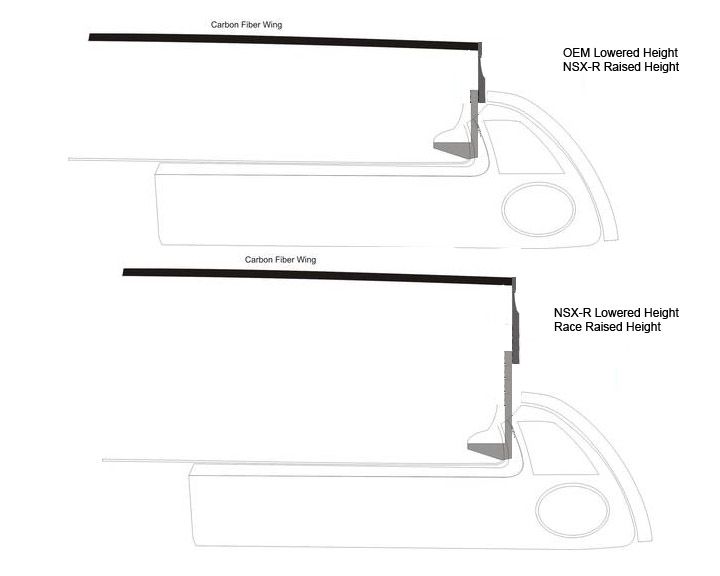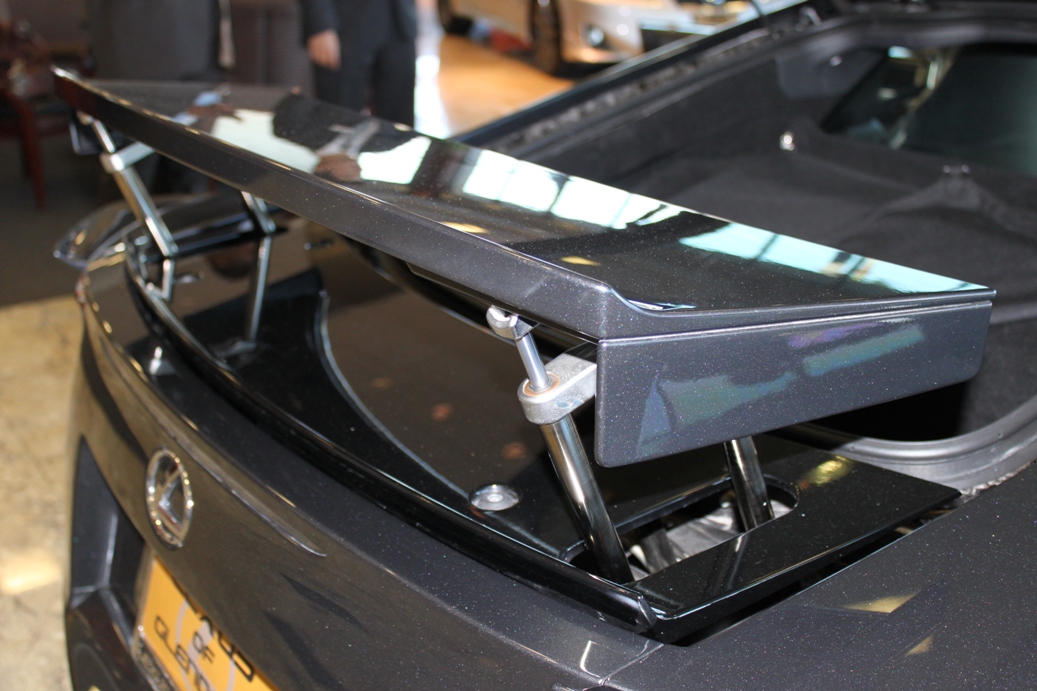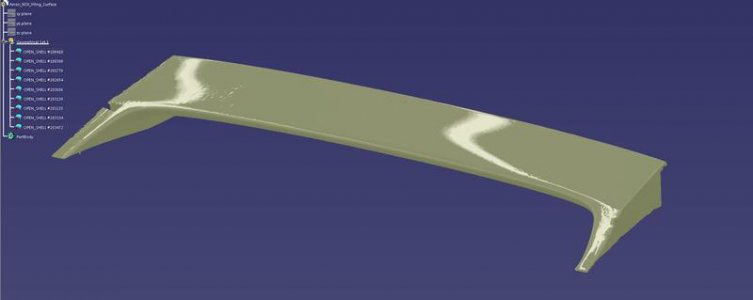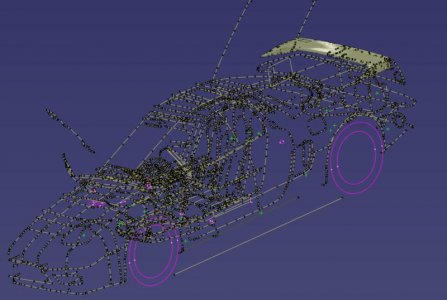Fair enough. We will keep this in mind when we design our wing. My concern is that the trunk is generally pretty full when going to the track so it's not ideal, but it seems like a reasonable design consideration. I appreciate your input.Sometimes the track can be 1000 km away and a large wing will attract even more attention from the cops on a red car...
I mean that even the "track" wing needs to look good.
-
Protip: Profile posts are public! Use Conversations to message other members privately. Everyone can see the content of a profile post.
You are using an out of date browser. It may not display this or other websites correctly.
You should upgrade or use an alternative browser.
You should upgrade or use an alternative browser.
Stock vs. NSX-R wing vs. GT Wing vs. Hybrid? - On track
- Thread starter stuntman
- Start date
I just got back from a week of testing so to catch up:
-I like that this thread is an open discussion of designs and ideas. The splitter/underbody tangent went to this thread (which unfortunately was relocated to the Vendors section): http://www.nsxprime.com/forum/showthread.php/178760-NSX-Splitter-Designs
-I like the different idea that jwmelvin is coming up with but I agree it would be nice to see some visual ideas, even if they are poorly executed photoshop/MS Paint drawings like I have made.
Some things to keep in mind:
-OEM wing height has no rearward visibility issues.
-NSX-R wings is double the height of OEM and is right in the middle of rearward view
-The higher you make a wing, the cleaner the airflow for more efficient downforce (more df, less drag)
-The OEM height is very close to the trunklid and sped up airflow under the wing is where the df is made.
-Dual element wings tend to make a lot of downforce, but adding one to the OEM height will start to obstruct rearward view like the NSX-R.
-Swan style mounting of wings are better than traditional under mounts, but still adversely affects a wings performance because there's still a vertical bracket in front of the wing. End-plate mounted wings (like my proposed design) uses the end plate as the mount (like an F1 car) and is more efficient than a swan-neck mount.
I think Dave is on the same page as me, but I have to say that adding the red section of wing and endplate in his "race wing end plate" design could have a big issue with strength. I modified his design a little, moving the wing-mounted upright to the outer side of the trunk mounted bracket (to increase the span of the wing) as well as to mount the wing to the upright for simplicity and adjustability. I have two designs below for a OEM-NSXR height adjustments, or NSX-R to 'race height':

Ideally you want the 'uprights'/end-plates as thin as possible for less drag, and an easily adjustable sliding mechanism adds bulk when compared to two flat 1/16 or 1/8" plates bolted together (which was my original idea, is the most simple, but harder to adjust than a sliding design). I would like to see more pics from Dave on his sliding design mechanism.
Objective of my design:
-"GT-wing" performance that's no wider than the OEM wing. Having the wing stick past the trunk width and over the fenders make the car look very 'racey' while IMO keeping the stock width, even at a higher height, would be more of a middle-ground that could be lived with every day.
Execution of my design:
-A proper airfoil the width of the stock wing - which will have ~60* of the span/downforce as a GT wing (but way more than NSX-R).
-Aluminum plate mounted to OEM trunk location
-Adjustable wing angle - via various holes in the carbon end-plate for AOA adjustments.
-*Adjustable uprights (which act like end-plates on the wing)
-From stock to NSX-R height (less performance but more streetable) OR
-From NSX-R height to GT height (for track use for improved efficiency by getting the wing into clean air).
-I like that this thread is an open discussion of designs and ideas. The splitter/underbody tangent went to this thread (which unfortunately was relocated to the Vendors section): http://www.nsxprime.com/forum/showthread.php/178760-NSX-Splitter-Designs
-I like the different idea that jwmelvin is coming up with but I agree it would be nice to see some visual ideas, even if they are poorly executed photoshop/MS Paint drawings like I have made.
Some things to keep in mind:
-OEM wing height has no rearward visibility issues.
-NSX-R wings is double the height of OEM and is right in the middle of rearward view
-The higher you make a wing, the cleaner the airflow for more efficient downforce (more df, less drag)
-The OEM height is very close to the trunklid and sped up airflow under the wing is where the df is made.
-Dual element wings tend to make a lot of downforce, but adding one to the OEM height will start to obstruct rearward view like the NSX-R.
-Swan style mounting of wings are better than traditional under mounts, but still adversely affects a wings performance because there's still a vertical bracket in front of the wing. End-plate mounted wings (like my proposed design) uses the end plate as the mount (like an F1 car) and is more efficient than a swan-neck mount.
I think Dave is on the same page as me, but I have to say that adding the red section of wing and endplate in his "race wing end plate" design could have a big issue with strength. I modified his design a little, moving the wing-mounted upright to the outer side of the trunk mounted bracket (to increase the span of the wing) as well as to mount the wing to the upright for simplicity and adjustability. I have two designs below for a OEM-NSXR height adjustments, or NSX-R to 'race height':

Ideally you want the 'uprights'/end-plates as thin as possible for less drag, and an easily adjustable sliding mechanism adds bulk when compared to two flat 1/16 or 1/8" plates bolted together (which was my original idea, is the most simple, but harder to adjust than a sliding design). I would like to see more pics from Dave on his sliding design mechanism.
Objective of my design:
-"GT-wing" performance that's no wider than the OEM wing. Having the wing stick past the trunk width and over the fenders make the car look very 'racey' while IMO keeping the stock width, even at a higher height, would be more of a middle-ground that could be lived with every day.
Execution of my design:
-A proper airfoil the width of the stock wing - which will have ~60* of the span/downforce as a GT wing (but way more than NSX-R).
-Aluminum plate mounted to OEM trunk location
-Adjustable wing angle - via various holes in the carbon end-plate for AOA adjustments.
-*Adjustable uprights (which act like end-plates on the wing)
-From stock to NSX-R height (less performance but more streetable) OR
-From NSX-R height to GT height (for track use for improved efficiency by getting the wing into clean air).
Last edited:
Welcome back! Hope the testing went well. As I've mentioned I'm in your/Dave's direction on this. I did ask a question that no one answered.
What is the required height off of the rear deck to get into a clean airflow for the wing? The Voltex Type 4 comes with 245mm risers, the Type 5 comes with 275mm ones and you can add an additional 30mm bracket if required. What is the window of optimal height for clean air, versus what will be possible from an OEM->GT vs NSX-R->GT design being developed here?
What is the required height off of the rear deck to get into a clean airflow for the wing? The Voltex Type 4 comes with 245mm risers, the Type 5 comes with 275mm ones and you can add an additional 30mm bracket if required. What is the window of optimal height for clean air, versus what will be possible from an OEM->GT vs NSX-R->GT design being developed here?
It did, thanks.Welcome back! Hope the testing went well. As I've mentioned I'm in your/Dave's direction on this. I did ask a question that no one answered.
What is the required height off of the rear deck to get into a clean airflow for the wing? The Voltex Type 4 comes with 245mm risers, the Type 5 comes with 275mm ones and you can add an additional 30mm bracket if required. What is the window of optimal height for clean air, versus what will be possible from an OEM->GT vs NSX-R->GT design being developed here?
In regards to height: generally the higher the better (for clean, efficient airflow and minimal lifting effect on the chassis) but as you raise the wing, the uprights get longer which increases drag. Around the height of the roof is generally a good ballpark. FWIW Grand-Am GT cars (now IMSA) are now allowed to have their wings slightly higher than the roofline where in previous years the roofline was their limit.
Again, the thinner the mounting brackets, the less drag and more efficient the wing will be. The NSX however has a trunk that gets smaller toward the rear and many wing mounts on the market for the NSX are very thick and wide, and are angled like the mounting plates on the trunk -which add a ton of drag.
From my end, unfortunately not. My brother's house was robbed, which was a bit of a setback since it included a CAD laptop, but he's getting it straightened out and expects to start designing soon. I've been toying with some alternative ideas for a height-adjustment mechanism. Also, since this is intended for street use in one configuration, we need to have a brake light. I think that the OEM module is a bit thick so replacing it looks to be a better plan; just more complication to the design.
From my end, unfortunately not. My brother's house was robbed, which was a bit of a setback since it included a CAD laptop, but he's getting it straightened out and expects to start designing soon. I've been toying with some alternative ideas for a height-adjustment mechanism. Also, since this is intended for street use in one configuration, we need to have a brake light. I think that the OEM module is a bit thick so replacing it looks to be a better plan; just more complication to the design.
I seem to remember a thread where Shawn in Tampa retro fitted a third brake lamp into the top of the rear canopy glass using an OEM Honda brake light from another car. Without that restriction, your new rear wing could be as thin as you like.
... third brake lamp into the top of the rear canopy glass using an OEM Honda brake light from another car.
I like this idea a lot and it makes the wing design a lot more straightforward. If this solution doesn't bother people I think it would allow us to design a wing more freely. Particularly one that can move up and down.
Unfortunately not. Arron has been in contact with the manufacturer, who is prepared to proceed once we have a design. I will push Arron a bit to get him to design it.
I volunteer for the car. Live in Dexter which is 8 miles away from Ann Arbor.
Arron and I have a new idea that I like much better. We will make a replacement for the OEM wing that will have an improved airfoil design and be a best effort at efficient downforce while remaining essentially within the OEM envelope. We both greatly prefer the look of the OEM wing to the type-R wing and I also value my rear view for daily driving.
But the key will be that our wing will have anchor points embedded in it and an attachment system so that an additional element may be mounted above the wing. This will allow a second element to be added for track use, which will give more downforce than ryneen's spoiler above, or a Gurney flap.
The attachment system also allows the addition of a variety of aero elements, which could potentially include a large GT-style wing. It would just maintain the OEM wing (and brake lights) below it. When no additional element is mounted above the base wing, cover plates would fill the attachment points.
We discussed a design that would be roughly type-R height with a interchangeable Gurney flap for tuning aero balance, but the second element will improve performance more than a Gurney flap and the design then allows us to stick with an OEM wing as the base.
I'm currently looking for a used OEM wing to send to Arron for the CAD model. We also would like a car in the Ann Arbor area that could go in to Pratt & Miller for white-light scanning so that we have the base shape. (It would be great to scan the front section too for a future underwing design.) I have a couple leads on used OEM wings from the marketplace but I prefer not to spend much since it's really just for measurement.
The thoughts in this thread have been extremely useful and I look forward to further ideas. Let me know how you guys feel about our new direction but I'm currently convinced that it will offer the performance and flexibility that we all seek. I think it will be the best-looking solution and will also be the quickest for changeover. The only downside perhaps is that when you run the base wing only, you would have an additional aero element to store. For me that's a nonissue but it is something to consider.
Best,
Jason
RYU, I am pretty sure I know a way to do this. I had planned to do this myself, but simply don't have the ambition or time.Thinking something like this. I've built more complicated stuff before so this can be done.

In to see where this goes!
Any more development on this idea?
Unclear. My brother is moving back to Europe as lead aero for an F1 team so I don't know whether he will have time. We may still try though.
Up
Well, what are your thoughts on whether it needs a brake light? That might make a difference to how easy it is to complete the design.
I think if you just made a gurney flap that is three pieces like the new car it would be a home run hit. Or just one piece that flows down the fenders. Granted it actually creates downforce. All aftermarket spoilers that ditch the brake light makes the rear look awkward and misplaced in my opinion. I have been waiting for someone to make something else in the spoiler department that stays oem and just adds on but in style.
Last edited:
I think if you just made a gurney flap that is three pieces like the new car it would be a home run hit. Or just one piece that flows down the fenders. Granted it actually creates downforce. All aftermarket spoilers that ditch the brake light makes the rear look awkward and misplaced in my opinion. I have been waiting for someone to make something else in the spoiler department that stays oem and just adds on but in style.
did you see the old Tommy Bahama whatever his name was gurney flap group buy?
Yes. That has to be used on type r wing which ditches the oem brake light unfortunately. Too bad cause I actually like it. I wonder if it creates good DF though.
If my brother and I make the wing we have been talking about, it will be a replacement for the OE wing, with a more efficient cross section. The idea would be to maintain the look of the stock wing. It will also have an integrated mounting system for a second element to increase downforce. That second element could have an optional Gurney flap for a higher-downforce configuration. Other than my brother now working in F1 and having zero free time, I would be responsible for the brake-light part and haven't thought about it much. My inclination is that I would want the replacement wing base section to have an integrated LED.
Similar threads
- Replies
- 3
- Views
- 675









